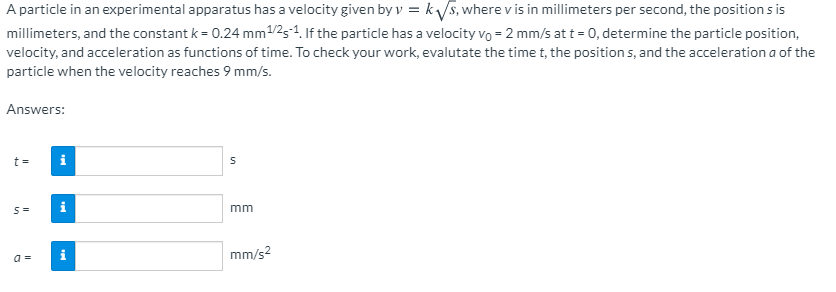A particle in an experimental apparatus has a velocity given by v = k/s, wherevis in millimeters per second, the position s is millimeters, and the constant k = 0.24 mm1/251. If the particle has a velocity vo = 2 mm/s at t = 0, determine the particle position, velocity, and acceleration as functions of time. To check your work, evalutate the time t, the position s, and the acceleration a of the particle when the velocity reaches 9 mm/s. Answers: S= mm mm/s? a =
A particle in an experimental apparatus has a velocity given by v = k/s, wherevis in millimeters per second, the position s is millimeters, and the constant k = 0.24 mm1/251. If the particle has a velocity vo = 2 mm/s at t = 0, determine the particle position, velocity, and acceleration as functions of time. To check your work, evalutate the time t, the position s, and the acceleration a of the particle when the velocity reaches 9 mm/s. Answers: S= mm mm/s? a =
Related questions
Question

Transcribed Image Text:A particle in an experimental apparatus has a velocity given by v = ks, where v is in millimeters per second, the position s is
millimeters, and the constant k = 0.24 mm1/25-1. If the particle has a velocity vo = 2 mm/s at t = 0, determine the particle position,
velocity, and acceleration as functions of time. To check your work, evalutate the time t, the position s, and the acceleration a of the
particle when the velocity reaches 9 mm/s.
Answers:
t =
i
i
mm
mm/s?
a =
Expert Solution
This question has been solved!
Explore an expertly crafted, step-by-step solution for a thorough understanding of key concepts.
This is a popular solution!
Trending now
This is a popular solution!
Step by step
Solved in 3 steps with 2 images
